Official Version. v1.7 adds 20 new celestial bodies bringing total count to 94 and system count to 11.
Added systems are LP 145-141, a theoretical white dwarf pulsar 15.11 ly away trapping 3 planets in it strong gravitational field. A newly discovered rogue planetary system 7.6 ly away, OGLE-2019-BLG-0551, and Procyon, a binary system very much similar to Sirius, 15.11 ly away.
Mercury, Uranus, Miranda, Neptune, and Triton now added to Sol.
Added orbital shipyard around Saturn and Titan fuel depot as launch locations.
For mission planning, also linked here is a spreadsheet with each planet's description and properties documented:
https://docs.google.com/spreadsheets/d/1TLWf9HPFFCZoT3EsDxMy-oXbMof6MFG8cIFMSrcrE0c/edit?usp=sharing
*Credit to sacr3dbac0n0 for placing the stars and adding the newest celestial bodies.
GENERAL INFO
- Predecessor: Stellar Neighborhood v1.7
- Created On: iOS
- Game Version: 0.9.802.0
CELESTIAL BODIES
| Name | Parent | Radius | Surface Gravity | Apoapsis | Periapsis |
|---|---|---|---|---|---|
| Sol | 139.1 Mm | 279.3 m/s | - | - | |
| Mercury | Sol | 588 km | 3.7 m/s | 4,004.0 Mm | 3,996.0 Mm |
| Venus | Sol | 1,210 km | 8.9 m/s | 10,294.6 Mm | 10,155.8 Mm |
| Earth | Sol | 1,274 km | 9.8 m/s | 15,124.5 Mm | 14,648.2 Mm |
| Luna | Earth | 350 km | 1.6 m/s | 41,485 km | 37,159 km |
| Mars | Sol | 678 km | 3.7 m/s | 24,832.6 Mm | 22,490.3 Mm |
| Jupiter | Sol | 13,980 km | 24.8 m/s | 78,139.0 Mm | 76,655.0 Mm |
| Io | Jupiter | 364 km | 1.8 m/s | 56,931 km | 56,588 km |
| Ganymede | Jupiter | 527 km | 1.4 m/s | 115.9 Mm | 113.7 Mm |
| Saturn | Sol | 11,400 km | 10.5 m/s | 148,195.9 Mm | 145,528.2 Mm |
| Saturn Orbital Shipyard | Saturn | 1 m | 0.1 m/s | 12,069 km | 12,045 km |
| Enceladus | Saturn | 50 km | 0.1 m/s | 47,387 km | 47,101 km |
| Titan | Saturn | 515 km | 1.4 m/s | 124.5 Mm | 119.4 Mm |
| Uranus | Sol | 5,073 km | 8.9 m/s | 301,547.5 Mm | 300,945.0 Mm |
| Miranda | Uranus | 47 km | 0.1 m/s | 24,283 km | 24,235 km |
| Neptune | Sol | 4,924 km | 11.2 m/s | 454,914.9 Mm | 454,006.0 Mm |
| Triton | Neptune | 270 km | 0.8 m/s | 40,570 km | 40,489 km |
| Alpha Centauri A | Sol | 170.2 Mm | 182.9 m/s | 41,356,315,002.0 Mm | 41,273,684,998.0 Mm |
| Alpha Centauri Ab | Alpha Centauri A | 4,100 km | 5.6 m/s | 4,218.1 Mm | 4,209.7 Mm |
| Alpha Centauri B | Alpha Centauri A | 120.1 Mm | 333.1 m/s | 301,178.7 Mm | 225,142.1 Mm |
| Alpha Centauri Bb | Alpha Centauri B | 960 km | 7.9 m/s | 10,347.6 Mm | 10,326.9 Mm |
| Alpha Centauri Bc | Alpha Centauri B | 2,080 km | 21.4 m/s | 18,260.7 Mm | 18,224.2 Mm |
| Alpha Centauri ABb | Alpha Centauri A | 5,200 km | 11.2 m/s | 816,937.7 Mm | 541,153.5 Mm |
| Alpha Centauri ABc | Alpha Centauri A | 14,700 km | 106.2 m/s | 2,661,307.6 Mm | 2,333,349.7 Mm |
| Alpha Centauri ABc I | Alpha Centauri ABc | 5,070 km | 8.9 m/s | 753.3 Mm | 751.8 Mm |
| Alpha Centauri ABc I i | Alpha Centauri ABc I | 180 km | 0.8 m/s | 44,772 km | 44,683 km |
| Proxima Centauri | Alpha Centauri A | 21,455 km | 1.41 km/s | 122,015,985.8 Mm | 121,772,197.6 Mm |
| Proxima Centauri B | Proxima Centauri | 1,363 km | 10.0 m/s | 588.1 Mm | 579.9 Mm |
| Proxima Centauri C | Proxima Centauri | 2,950 km | 12.6 m/s | 20,768.7 Mm | 19,586.7 Mm |
| Proxima Centauri C I | Proxima Centauri C | 32 km | 0.2 m/s | 52,898 km | 34,600 km |
| Barnard’s Star | Sol | 27,228 km | 1.05 km/s | 56,469,803,392.7 Mm | 56,356,976,607.3 Mm |
| Barnard’s Star B | Barnard’s Star | 610 km | 4.8 m/s | 274.7 Mm | 274.1 Mm |
| Barnard’s Star C | Barnard’s Star | 1,210 km | 8.8 m/s | 628.9 Mm | 615.1 Mm |
| Barnard’s Star D | Barnard’s Star | 6,500 km | 9.7 m/s | 2,209.6 Mm | 2,205.2 Mm |
| Barnard’s Star D I | Barnard’s Star D | 220 km | 1.5 m/s | 28,005 km | 27,949 km |
| Barnard’s Star D II | Barnard’s Star D | 140 km | 0.6 m/s | 52,539 km | 52,434 km |
| Luhman 16 Barycenter | Sol | 2,000 m | 78,326,496.26 km/s | 61,583,702,182.9 Mm | 61,460,657,817.1 Mm |
| Luhman 16 A | Luhman 16 Barycenter | 11,885 km | 1.23 km/s | 46,217.0 Mm | 46,124.6 Mm |
| Luhman 16 Ab | Luhman 16 A | 950 km | 7.1 m/s | 103.6 Mm | 98,505 km |
| Luhman 16 Ac | Luhman 16 A | 15,500 km | 23.0 m/s | 4,010.9 Mm | 3,986.7 Mm |
| Luhman 16 Ac I | Luhman 16 Ac | 10 km | 0.1 m/s | 63,610 km | 63,483 km |
| Luhman 16 Ac II | Luhman 16 Ac | 320 km | 2.6 m/s | 123.9 Mm | 121.1 Mm |
| Luhman 16 B | Luhman 16 Barycenter | 14,542 km | 690.4 m/s | 46,217.0 Mm | 46,124.6 Mm |
| Luhman 16 Bb | Luhman 16 B | 1,900 km | 22.5 m/s | 397.0 Mm | 396.2 Mm |
| OGLE 2019 BLG 0551 | Sol | 1,850 km | 35.9 m/s | 76,760,392,101.9 Mm | 67,039,607,898.1 Mm |
| OGLE 2019 BLG 0551 B | OGLE 2019 BLG 0551 | 800 km | 3.4 m/s | 19,054 km | 9,324 km |
| Sirius A | Sol | 238.1 Mm | 192.6 m/s | 81,547,866,403.9 Mm | 81,384,933,596.1 Mm |
| Sirius Ab | Sirius A | 805 km | 6.2 m/s | 49,836.0 Mm | 49,736.5 Mm |
| Sirius B | Sirius A | 1,170 km | 4,028.50 km/s | 330,615.0 Mm | 152,205.1 Mm |
| Sirius Bb | Sirius B | 3,180 km | 31.5 m/s | 376.2 Mm | 134.8 Mm |
| Sirius Bc | Sirius B | 2,340 km | 23.2 m/s | 42,014.7 Mm | 39,623.6 Mm |
| Sirius ABb | Sirius A | 92,400 km | 3.8 m/s | 946,614.5 Mm | 627,053.6 Mm |
| Sirius ABb I | Sirius ABb | 1,080 km | 7.7 m/s | 97,196 km | 97,002 km |
| Sirius ABc | Sirius A | 6,900 km | 8.5 m/s | 1,718,352.8 Mm | 1,549,977.9 Mm |
| Sirius ABd | Sirius A | 15,100 km | 33.4 m/s | 7,010,967.3 Mm | 6,298,412.9 Mm |
| Sirius ABd I | Sirius ABd | 1,645 km | 4.8 m/s | 348.5 Mm | 347.8 Mm |
| Epsilon Eridani | Sol | 102.4 Mm | 423.0 m/s | 99,200,251,154.7 Mm | 99,002,048,845.3 Mm |
| Epsilon Eridani B | Epsilon Eridani | 481 km | 10.2 m/s | 4,903.4 Mm | 4,893.6 Mm |
| Epsilon Eridani C | Epsilon Eridani | 1,010 km | 7.8 m/s | 10,022.9 Mm | 10,002.9 Mm |
| Epsilon Eridani C I | Epsilon Eridani C | 450 km | 2.1 m/s | 9,679 km | 9,660 km |
| Epsilon Eridani D | Epsilon Eridani | 2,400 km | 5.4 m/s | 24,070.1 Mm | 24,022.0 Mm |
| Epsilon Eridani D I | Epsilon Eridani D | 510 km | 3.6 m/s | 32,788 km | 32,722 km |
| Epsilon Eridani E | Epsilon Eridani | 11,600 km | 9.4 m/s | 96,893.1 Mm | 96,699.5 Mm |
| Epsilon Eridani E I | Epsilon Eridani E | 130 km | 0.7 m/s | 88,695 km | 88,518 km |
| Epsilon Eridani E II | Epsilon Eridani E | 370 km | 1.5 m/s | 205.5 Mm | 205.1 Mm |
| Procyon A | Sol | 141.7 Mm | 230.6 m/s | 108,528,420,005.2 Mm | 108,311,579,994.9 Mm |
| Procyon Ab | Procyon A | 1,036 km | 10.7 m/s | 1,501.5 Mm | 1,498.5 Mm |
| Procyon Ac | Procyon A | 750 km | 6.5 m/s | 25,330.1 Mm | 25,279.5 Mm |
| Procyon Ac I | Procyon Ac | 250 km | 1.5 m/s | 7,882 km | 5,962 km |
| Procyon Ae | Procyon A | 40 km | 0.2 m/s | 105,703.8 Mm | 55,455.0 Mm |
| Procyon Ad | Procyon A | 8,700 km | 40.0 m/s | 158,983.6 Mm | 154,494.6 Mm |
| Procyon Ad I | Procyon Ad | 801 km | 6.0 m/s | 37,252 km | 37,177 km |
| Procyon Ad II | Procyon Ad | 20 km | 0.1 m/s | 112.3 Mm | 72,694 km |
| Procyon B | Procyon A | 1,717 km | 1,085.70 km/s | 1,180,871.5 Mm | 1,178,512.1 Mm |
| Tau Ceti | Sol | 110.4 Mm | 337.0 m/s | 112,742,630,005.4 Mm | 112,517,369,994.7 Mm |
| Tau Ceti B | Tau Ceti | 1,100 km | 11.8 m/s | 4,042.4 Mm | 4,034.4 Mm |
| Tau Ceti C | Tau Ceti | 1,270 km | 7.8 m/s | 9,935.4 Mm | 9,915.6 Mm |
| Tau Ceti D | Tau Ceti | 1,340 km | 12.8 m/s | 14,246.1 Mm | 14,103.2 Mm |
| Tau Ceti D I | Tau Ceti D | 110 km | 0.5 m/s | 4,968 km | 4,573 km |
| Tau Ceti E | Tau Ceti | 8,300 km | 7.6 m/s | 42,141.5 Mm | 42,057.3 Mm |
| Tau Ceti E I | Tau Ceti E | 1,457 km | 11.3 m/s | 45,351 km | 45,260 km |
| Tau Ceti F Barycenter | Tau Ceti | 2,000 m | 1,423.25 km/s | 73,443.9 Mm | 73,297.2 Mm |
| Tau Ceti Fb | Tau Ceti F Barycenter | 800 km | 4.7 m/s | 9,800 km | 9,780 km |
| Tau Ceti Fa | Tau Ceti F Barycenter | 780 km | 4.4 m/s | 9,800 km | 9,780 km |
| Wolf 1061 | Sol | 42,755 km | 877.7 m/s | 132,961,829,006.3 Mm | 132,696,170,993.7 Mm |
| Wolf 1061 B | Wolf 1061 | 670 km | 5.2 m/s | 1,212.7 Mm | 1,210.3 Mm |
| Wolf 1061 C | Wolf 1061 | 1,310 km | 10.8 m/s | 2,061.6 Mm | 2,057.5 Mm |
| Wolf 1061 D | Wolf 1061 | 1,610 km | 16.7 m/s | 3,761.8 Mm | 3,754.3 Mm |
| Wolf 1061 E | Wolf 1061 | 15,500 km | 23.0 m/s | 22,563.0 Mm | 22,517.9 Mm |
| Wolf 1061 E I | Wolf 1061 E | 625 km | 4.9 m/s | 27,252 km | 27,197 km |
| Wolf 1061 E II | Wolf 1061 E | 312 km | 1.7 m/s | 155.6 Mm | 155.3 Mm |
| LP 145-141 | Sol | 300 km | 44,252.26 km/s | 143,094,952,006.8 Mm | 142,809,047,993.2 Mm |
| LP 145-141 b | LP 145-141 | 2,500 km | 321.0 m/s | 24,518 km | 24,469 km |
| LP 145-141 c | LP 145-141 | 1,192 km | 29.7 m/s | 64,668 km | 62,048 km |
| LP 145-141 d | LP 145-141 | 610 km | 5.5 m/s | 3,359.6 Mm | 2,055.8 Mm |

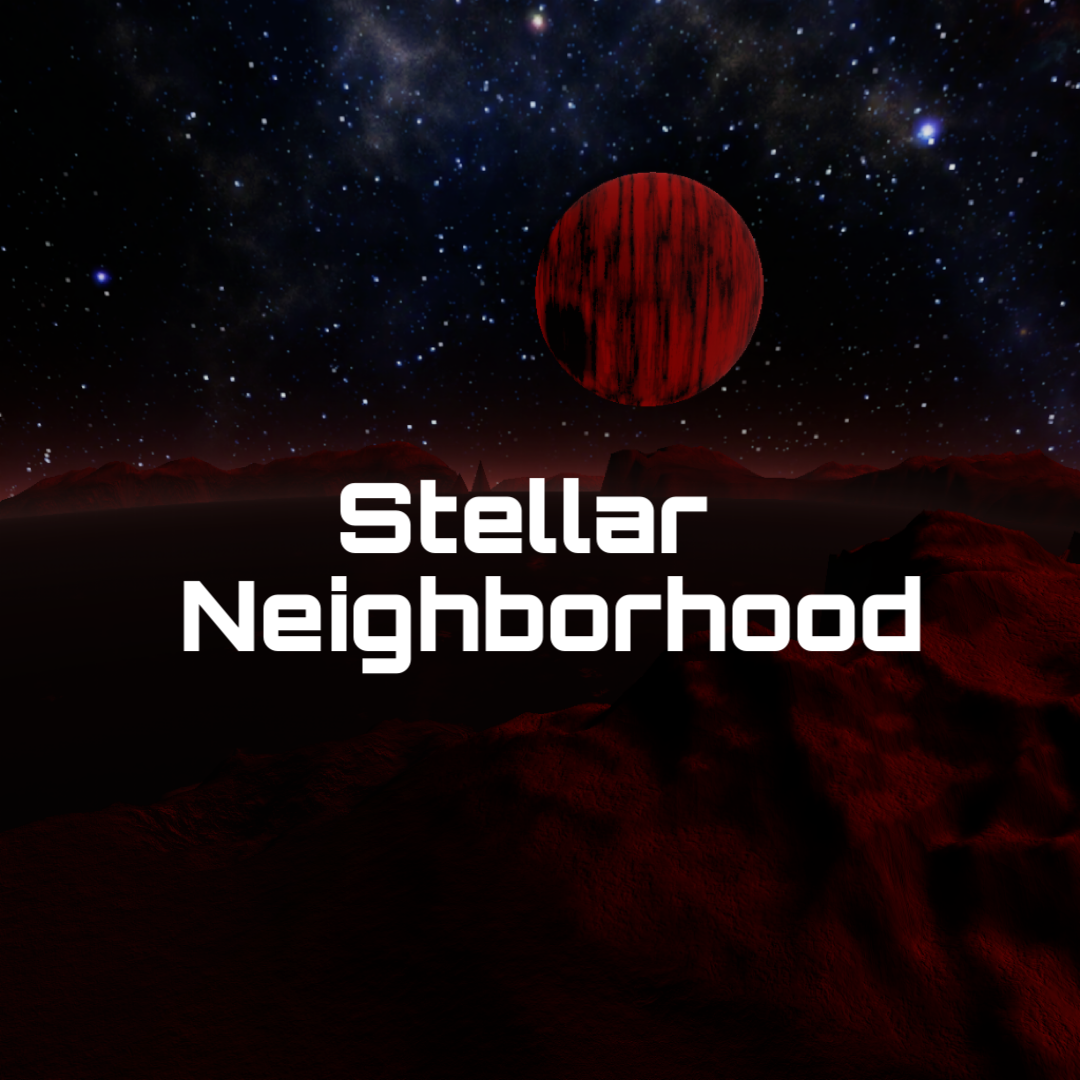
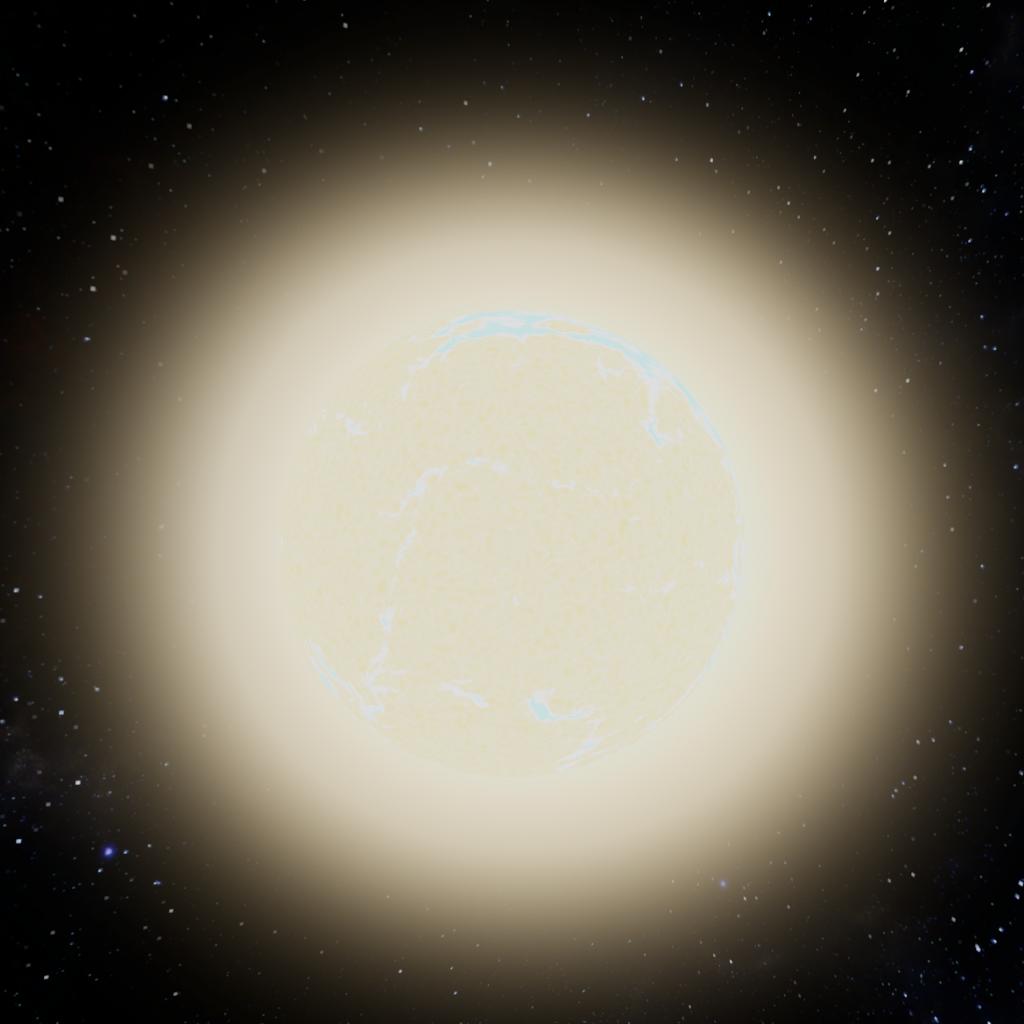

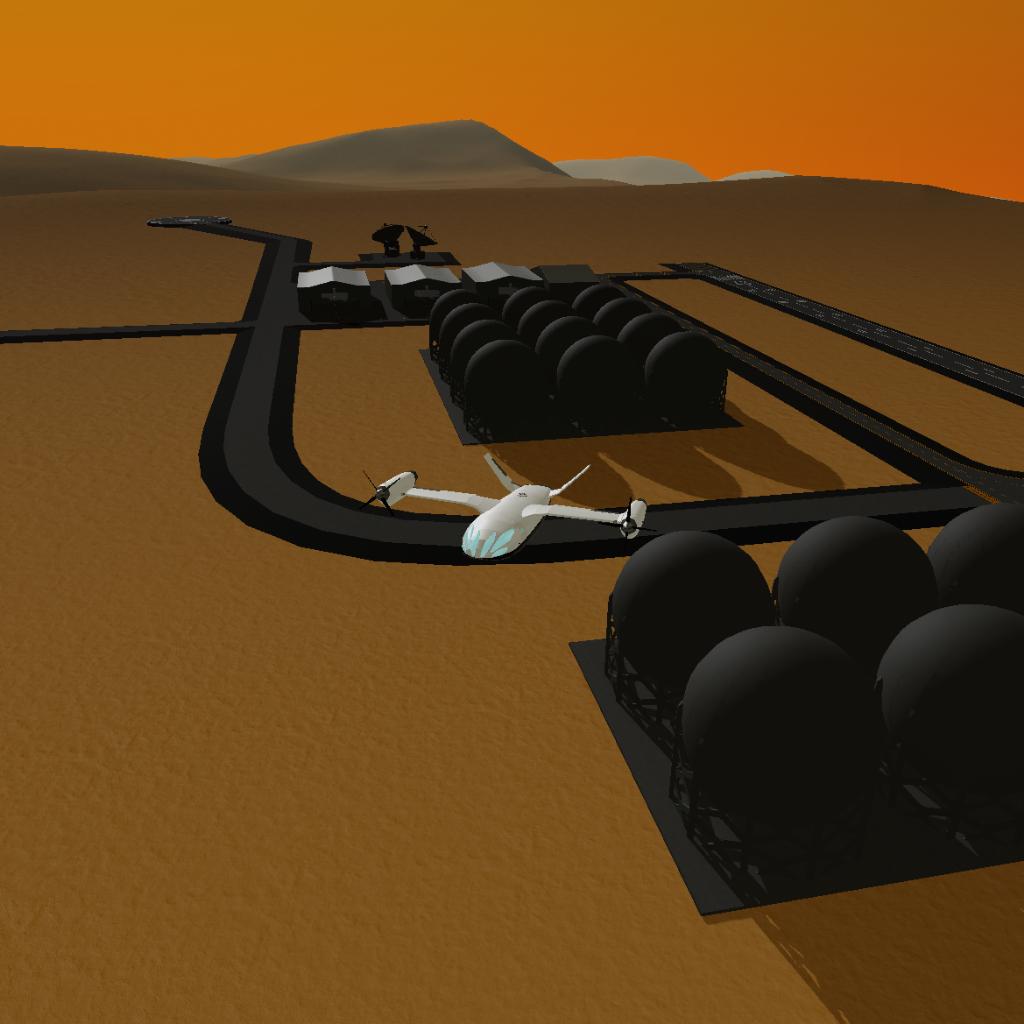
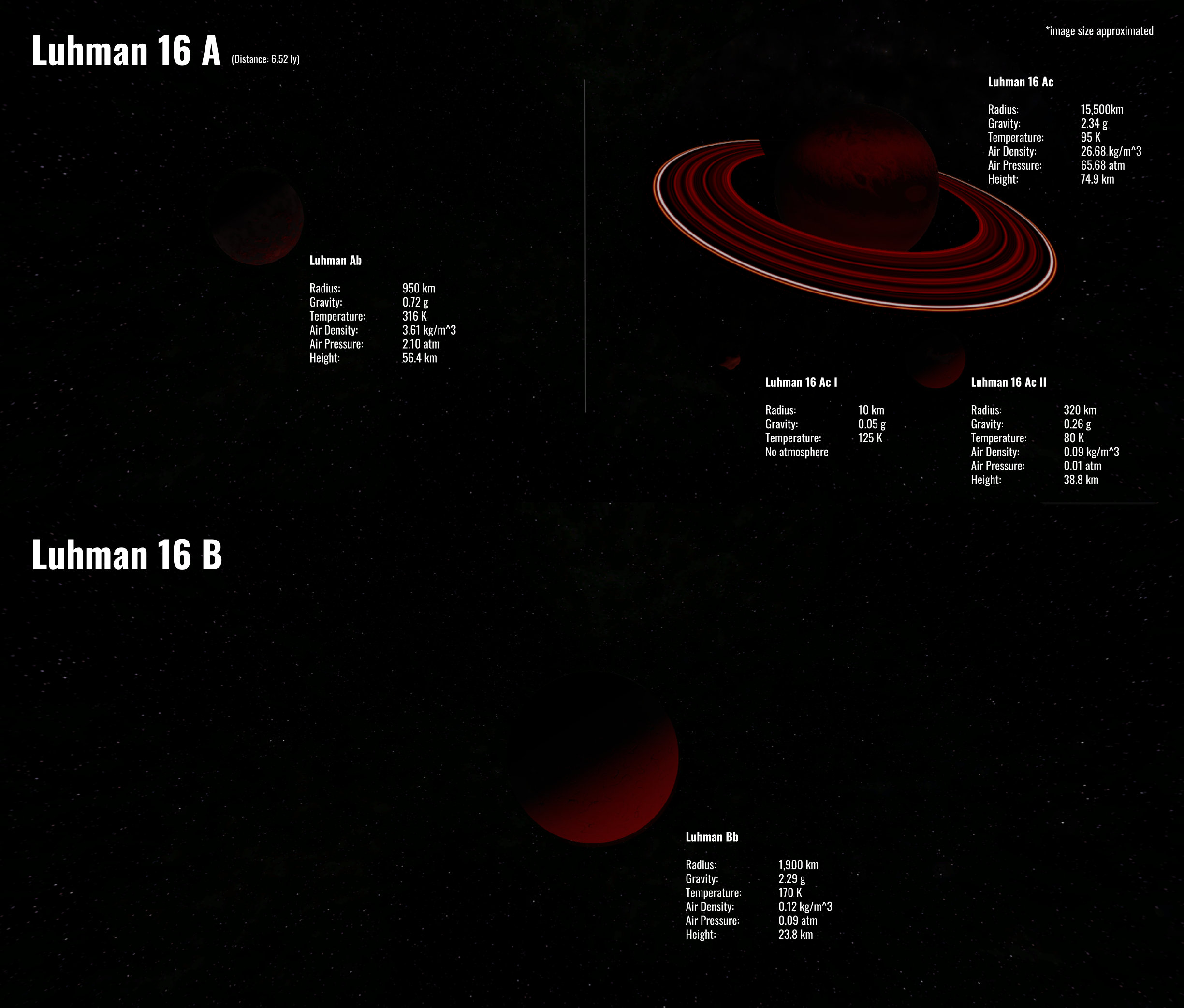

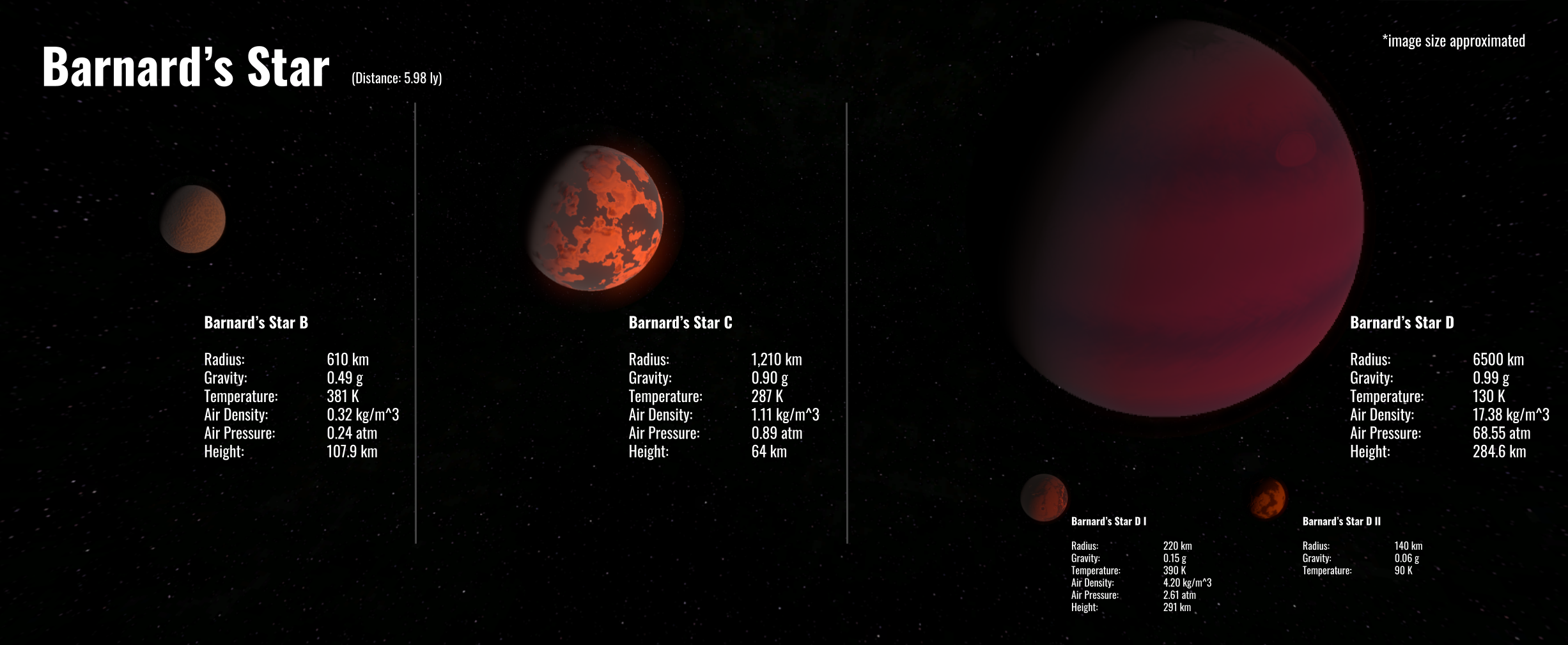
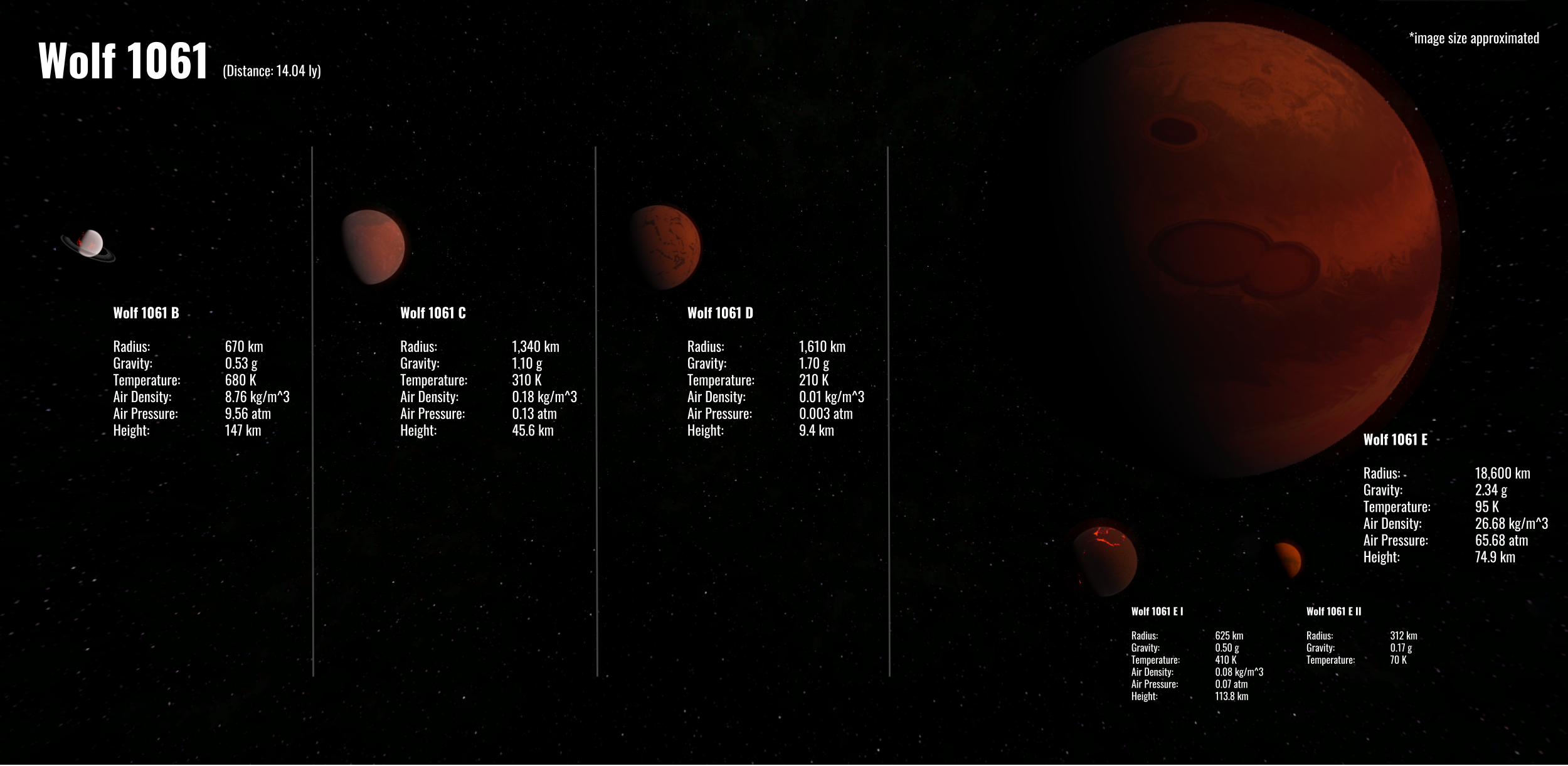
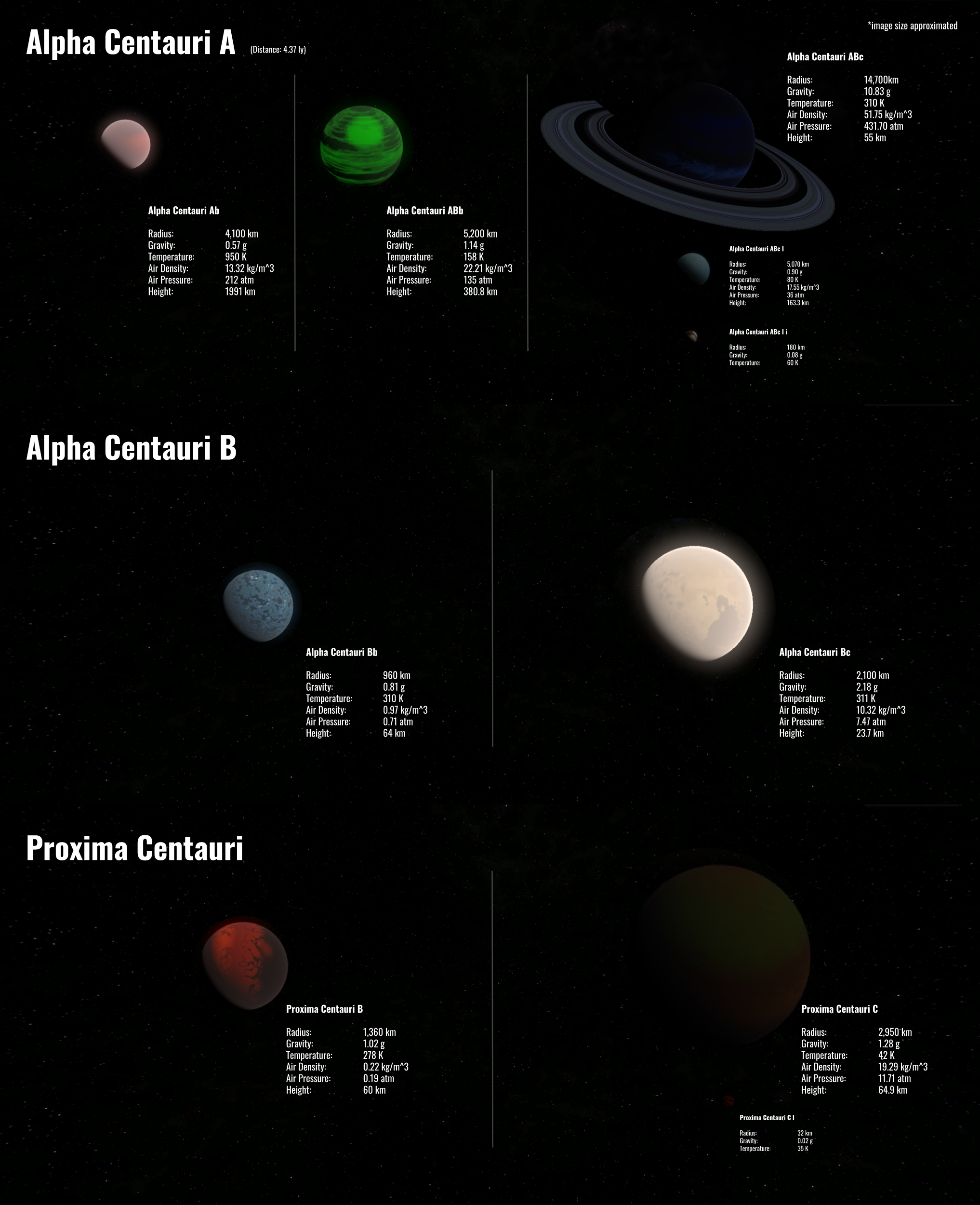

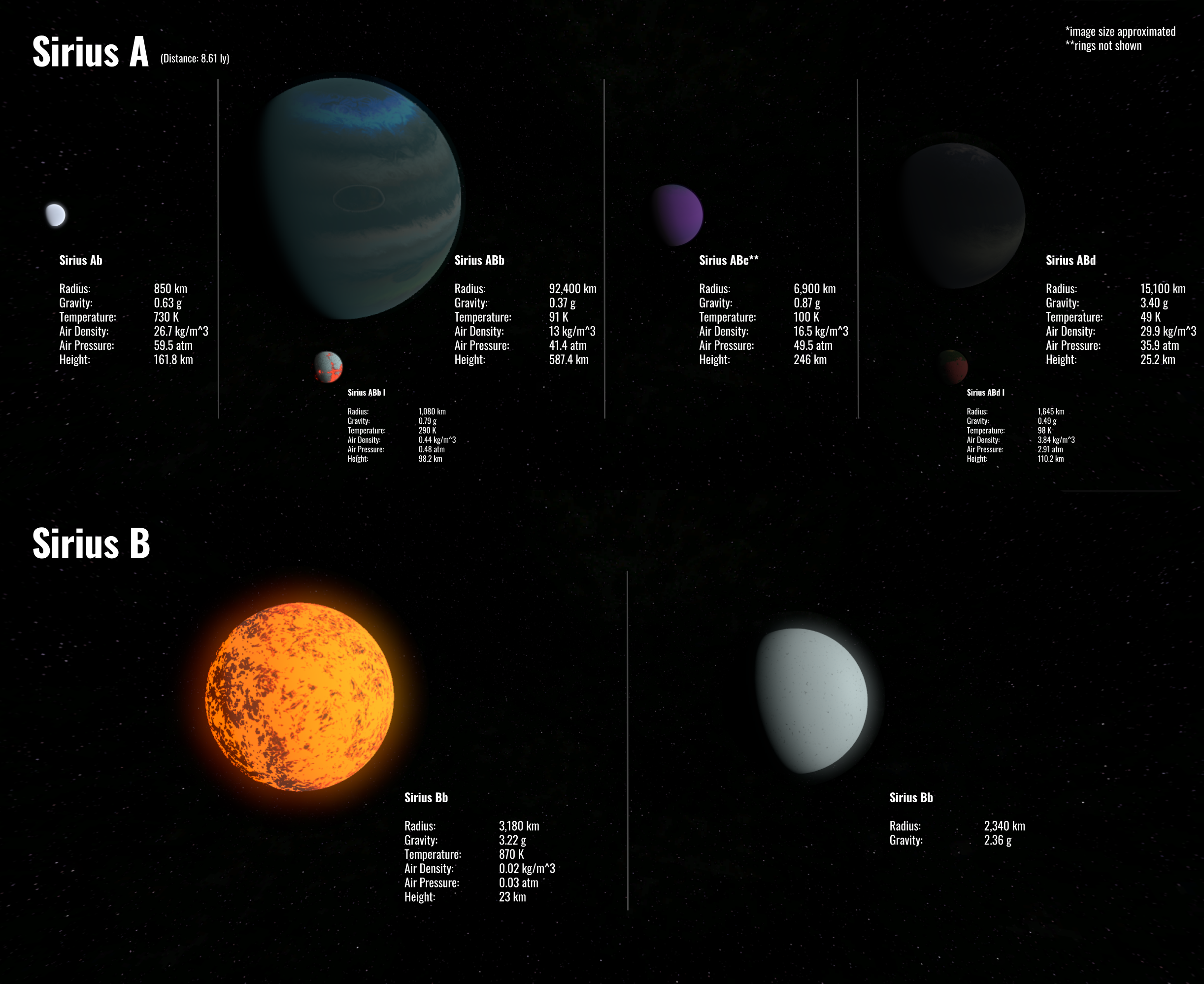

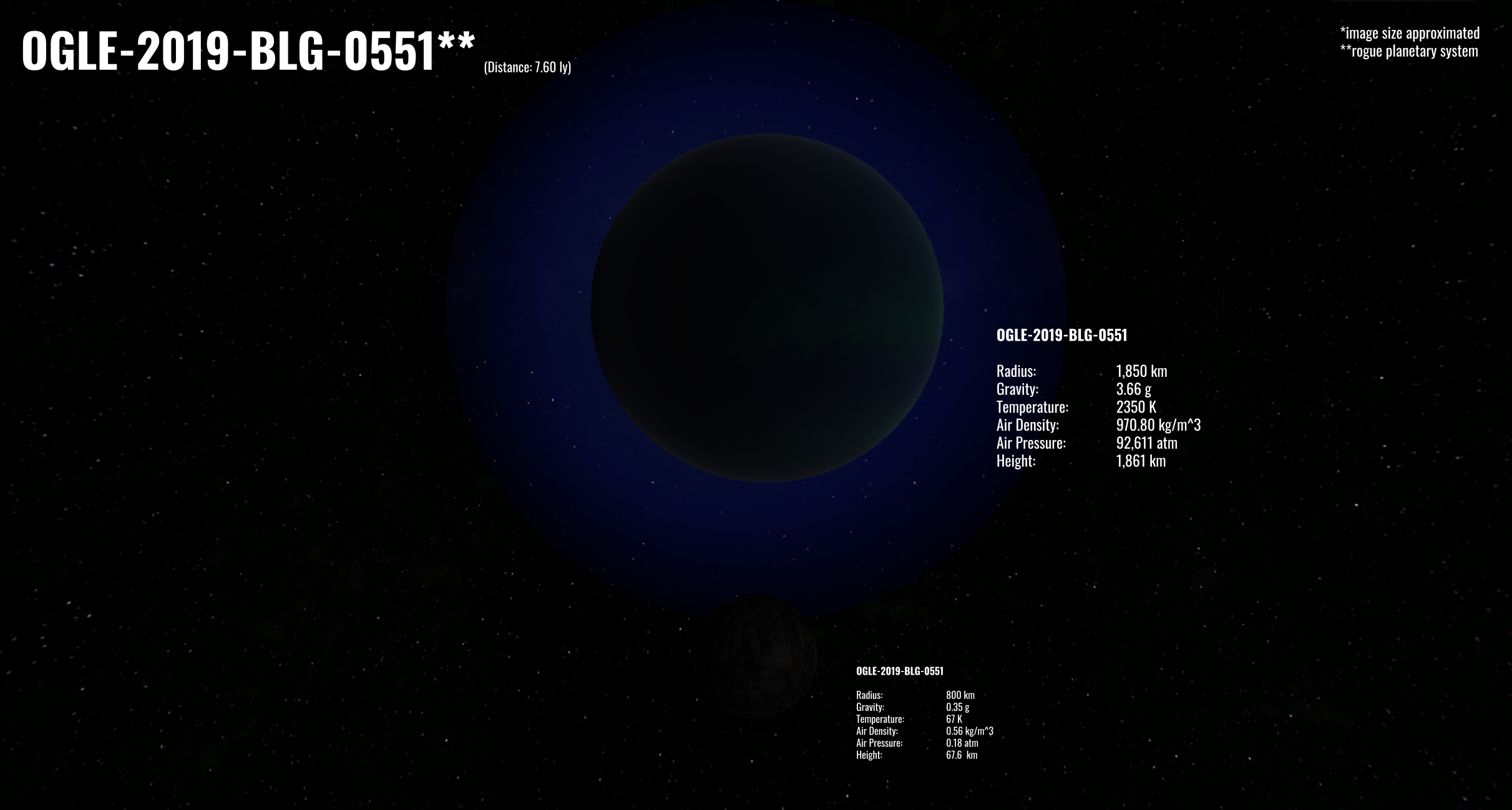
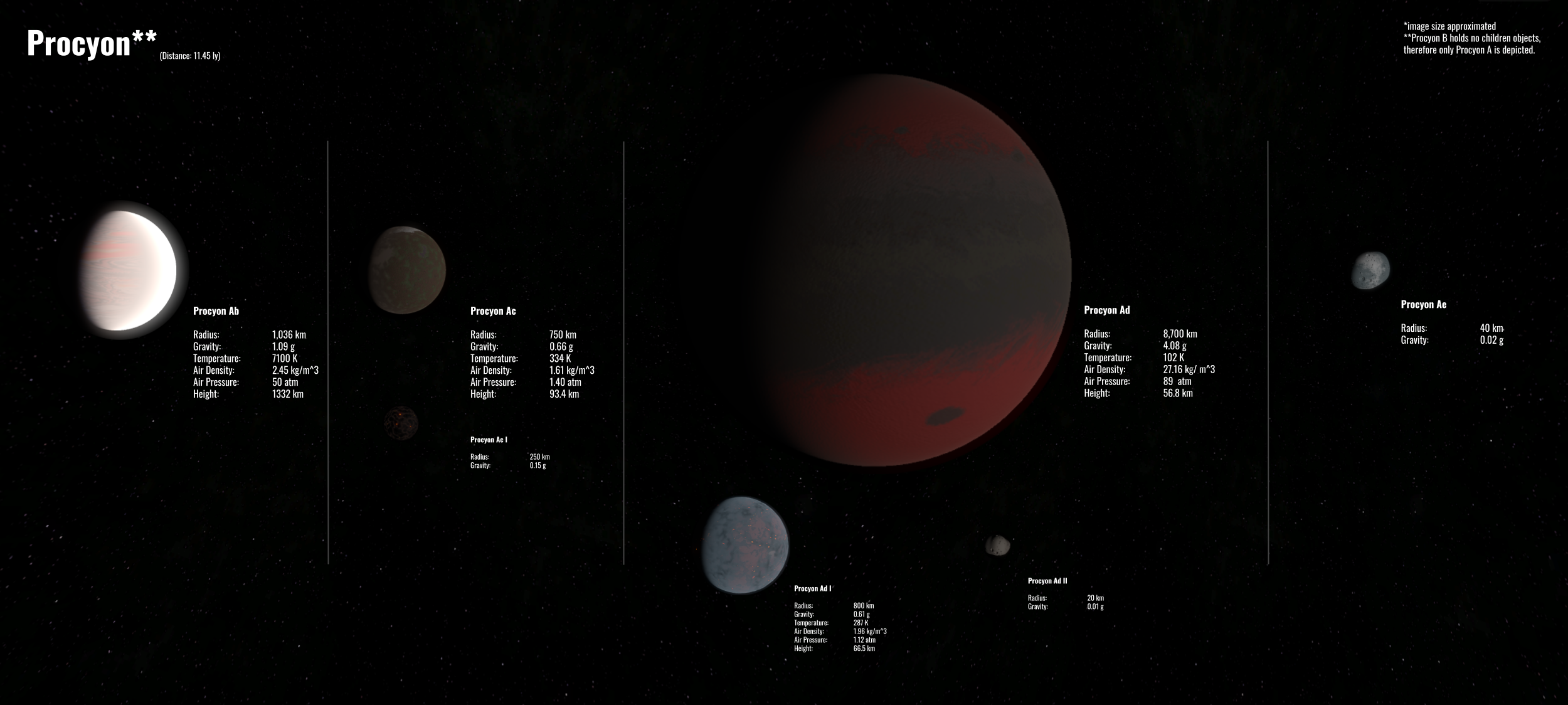


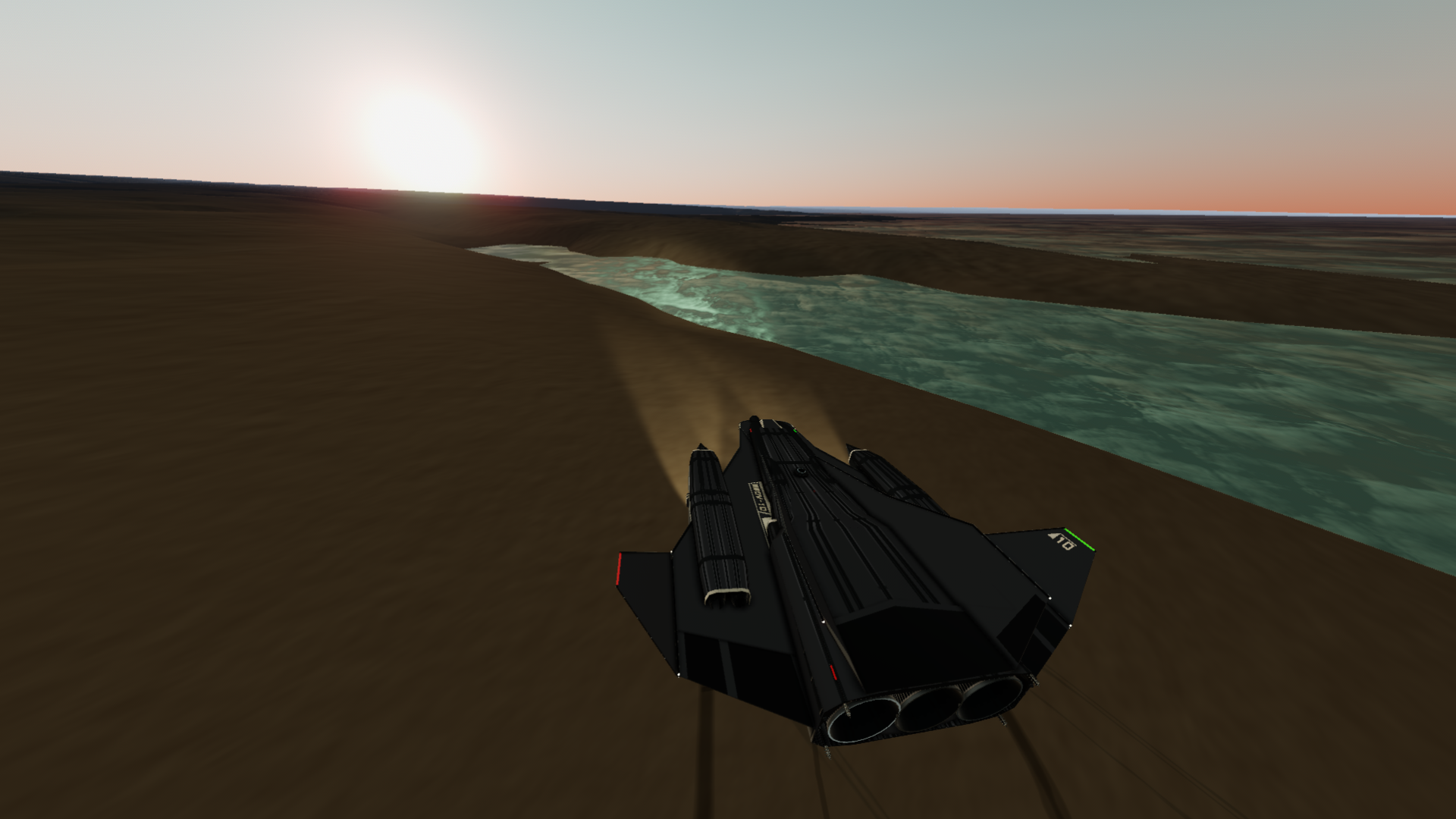
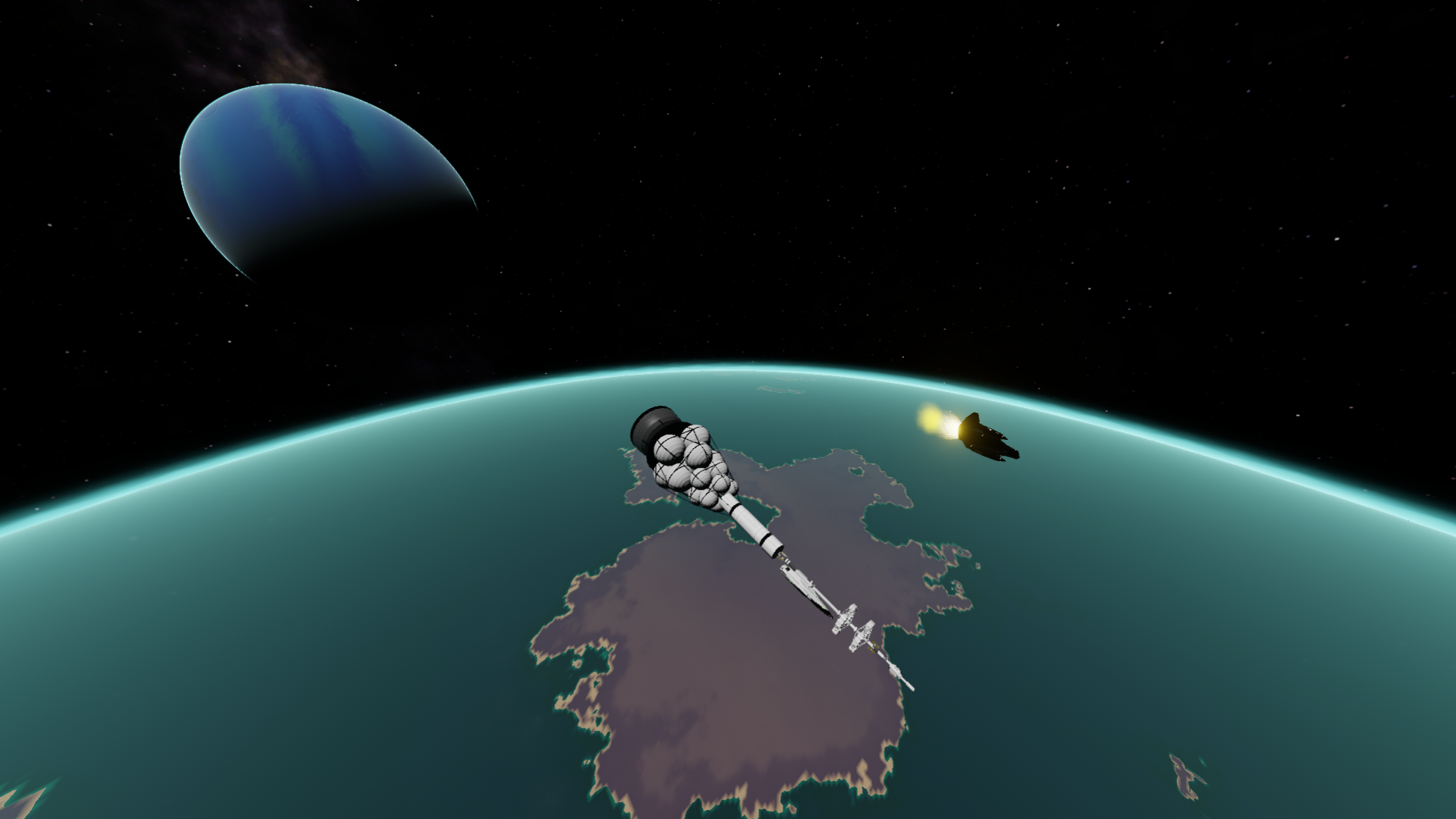
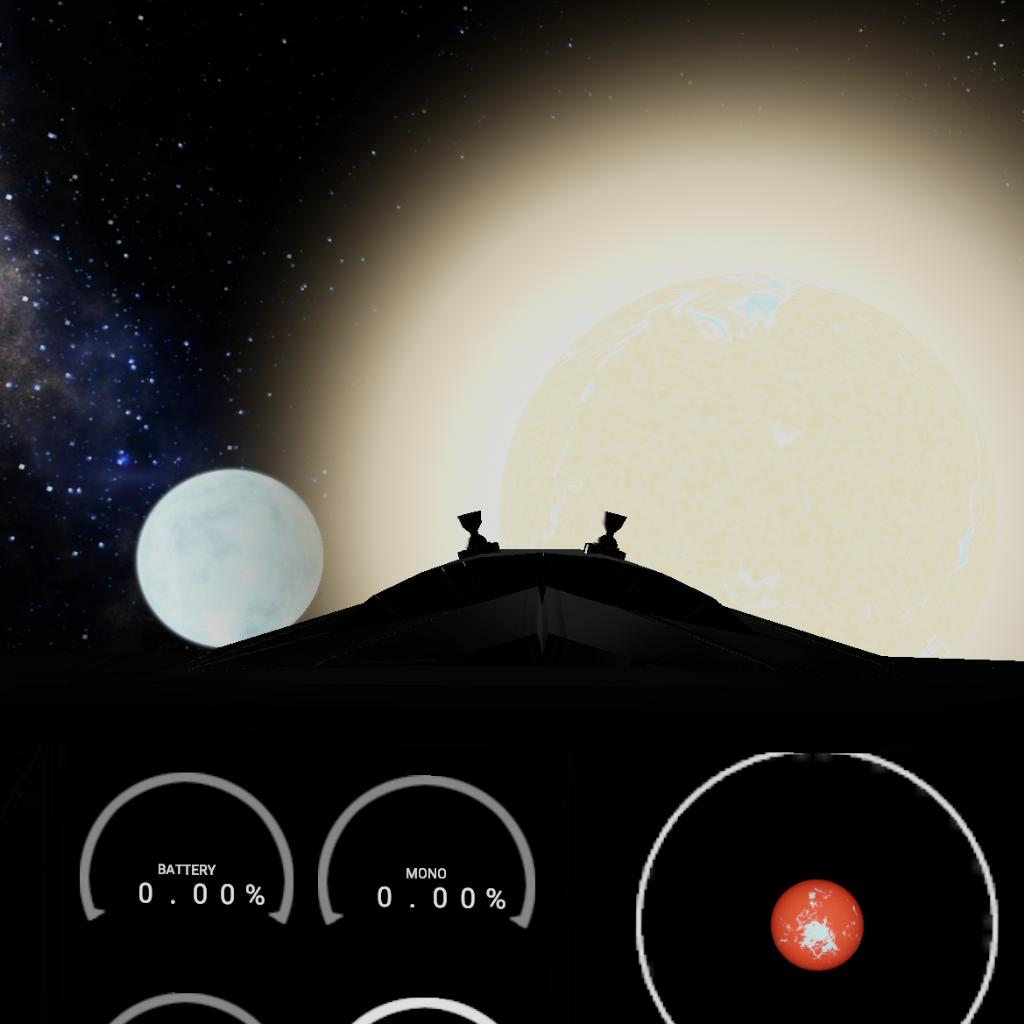
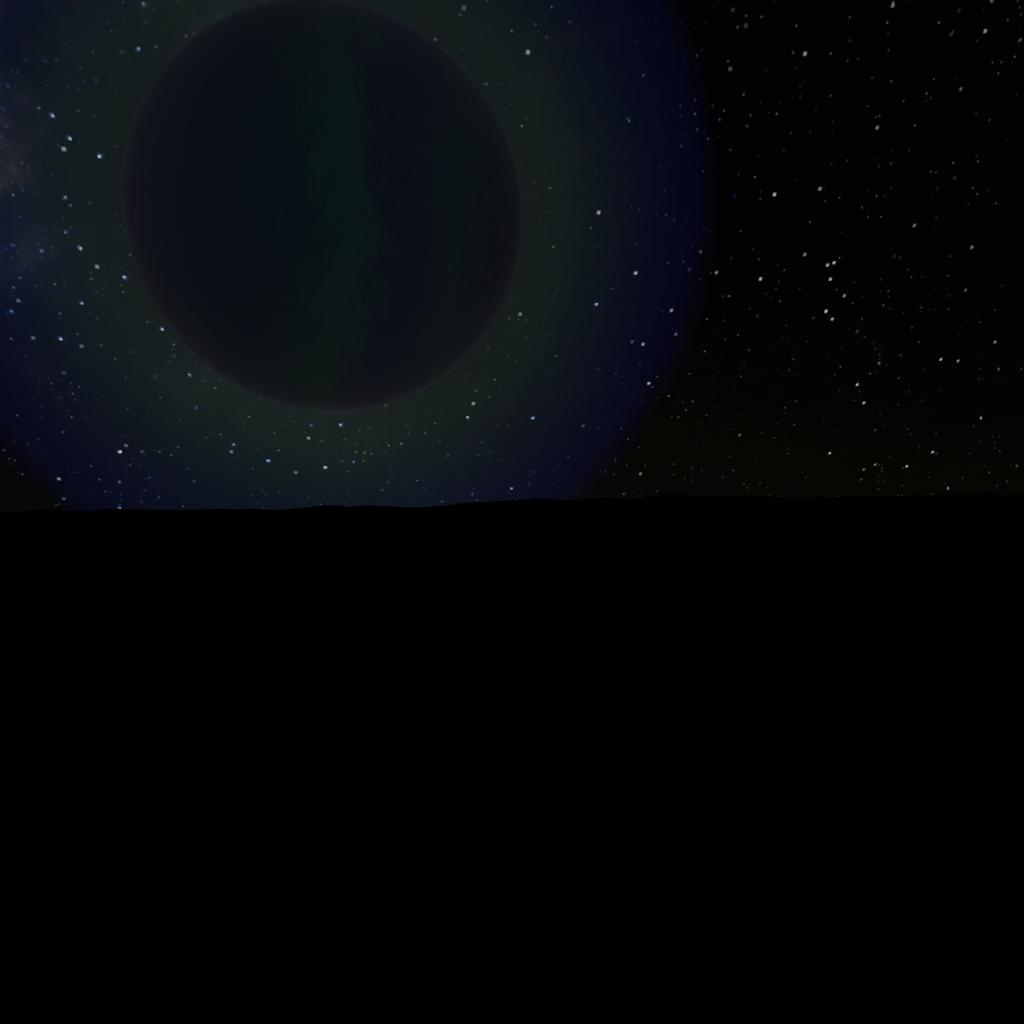
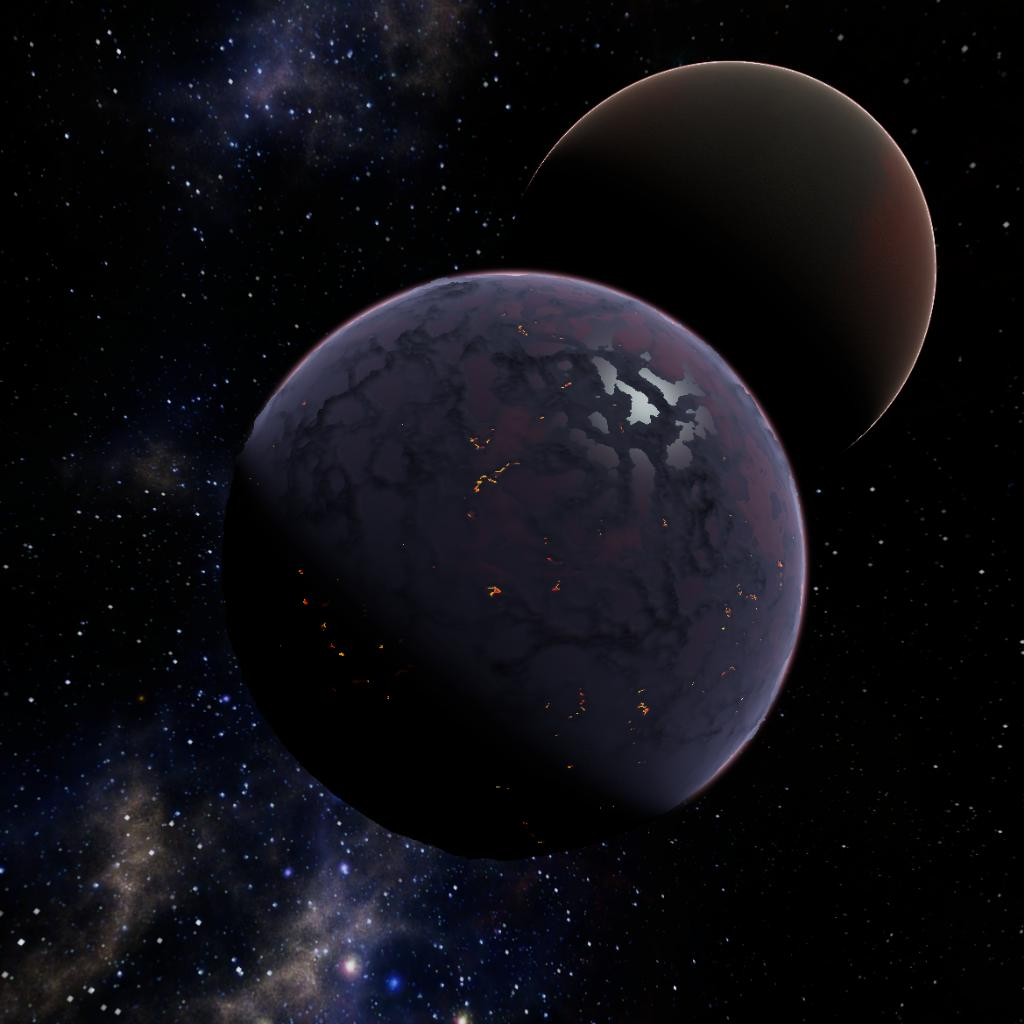
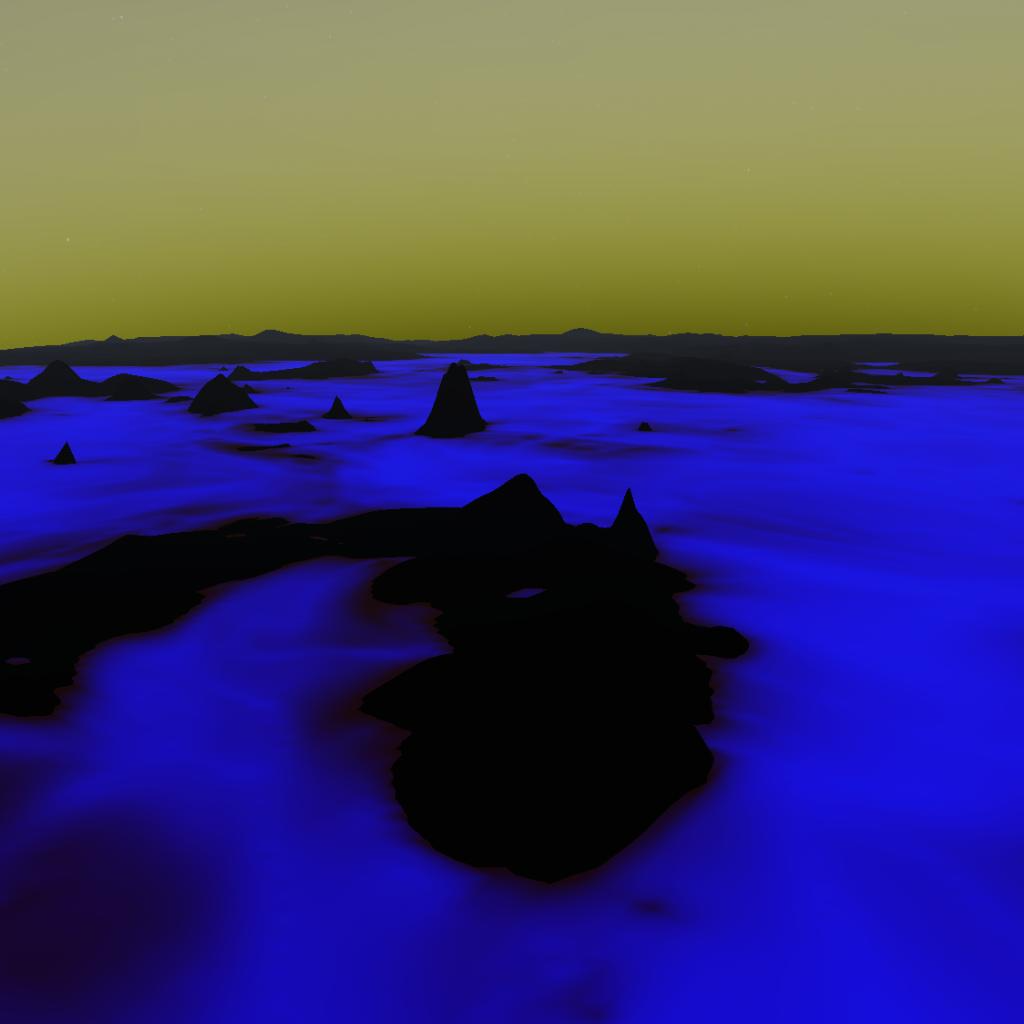
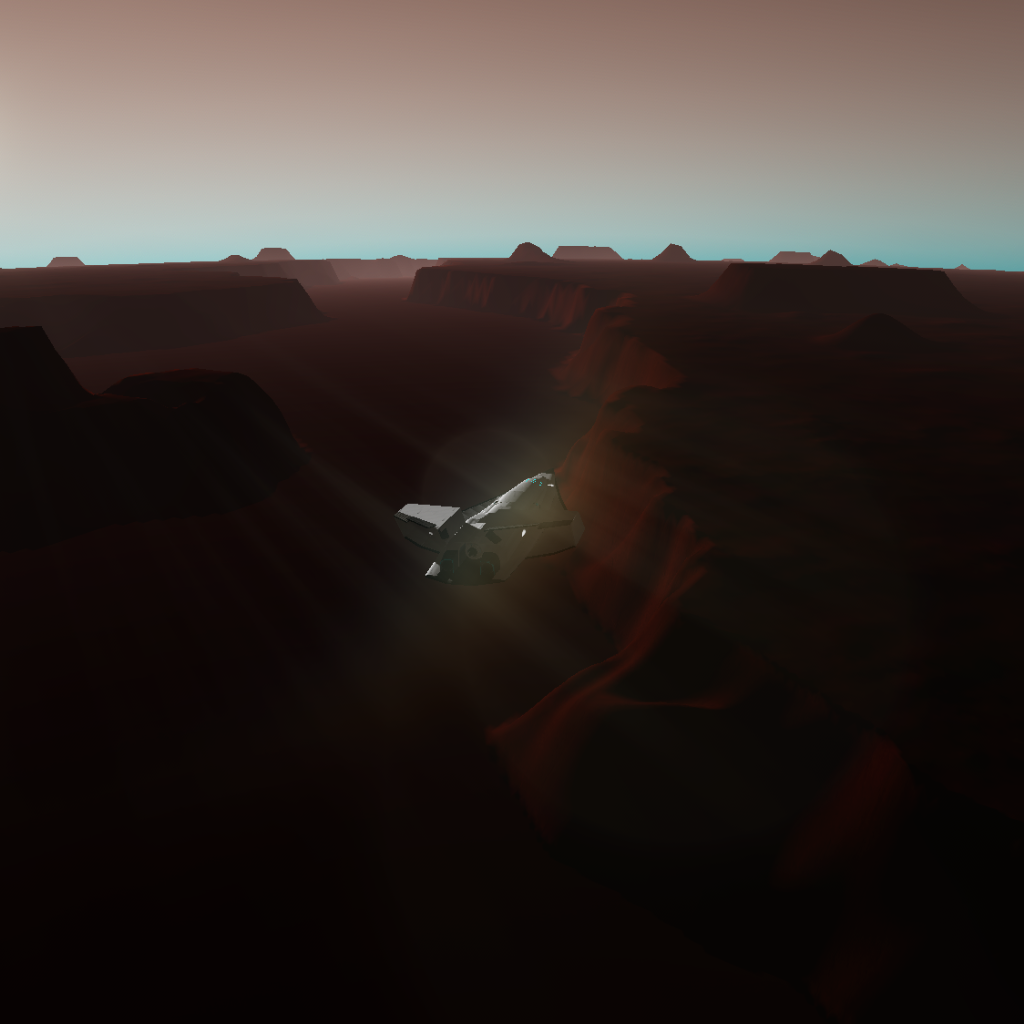
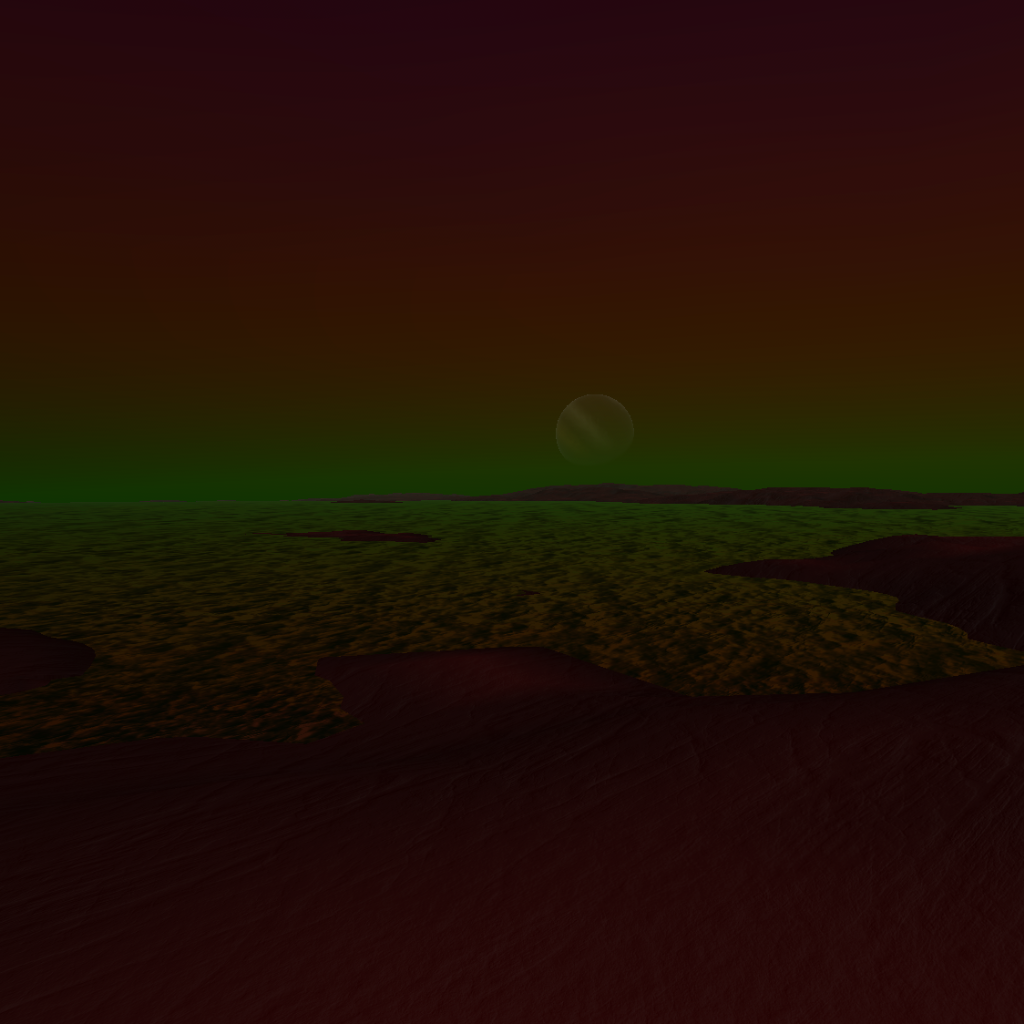
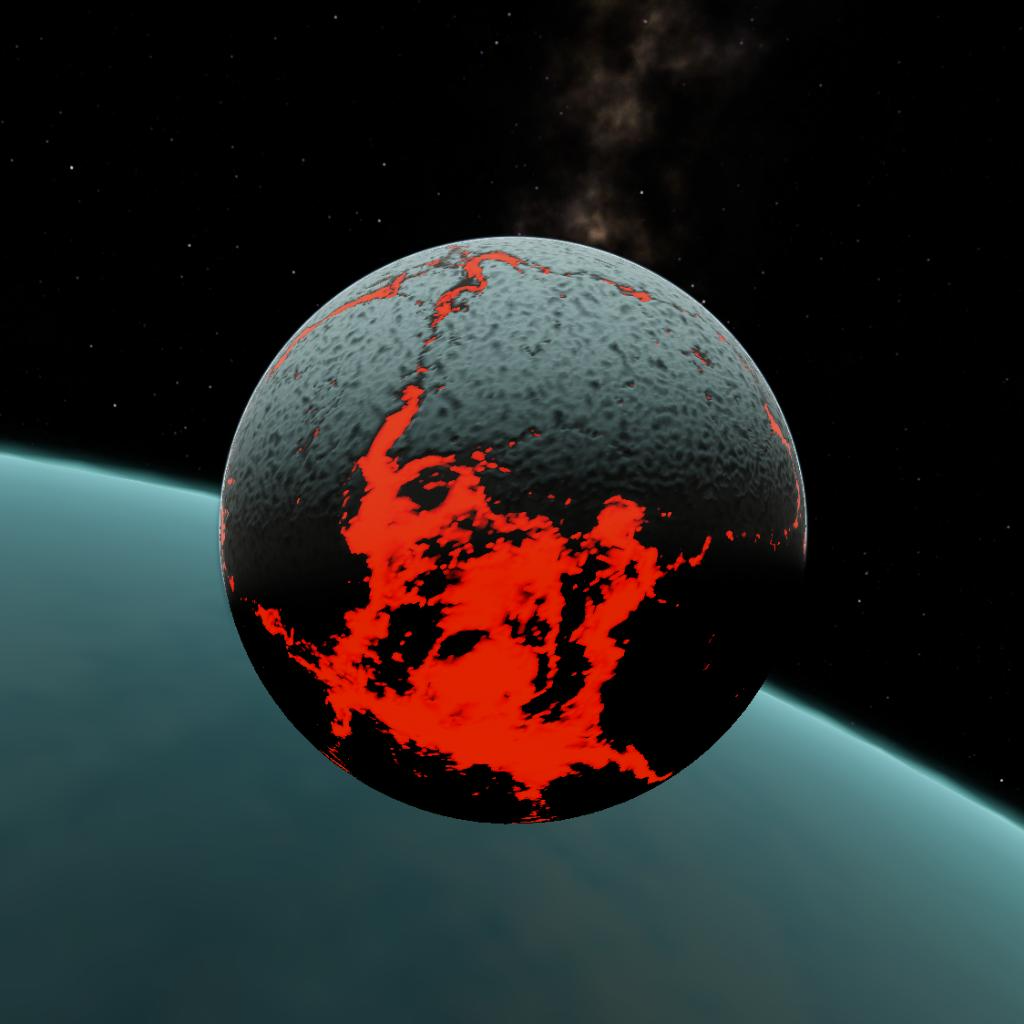
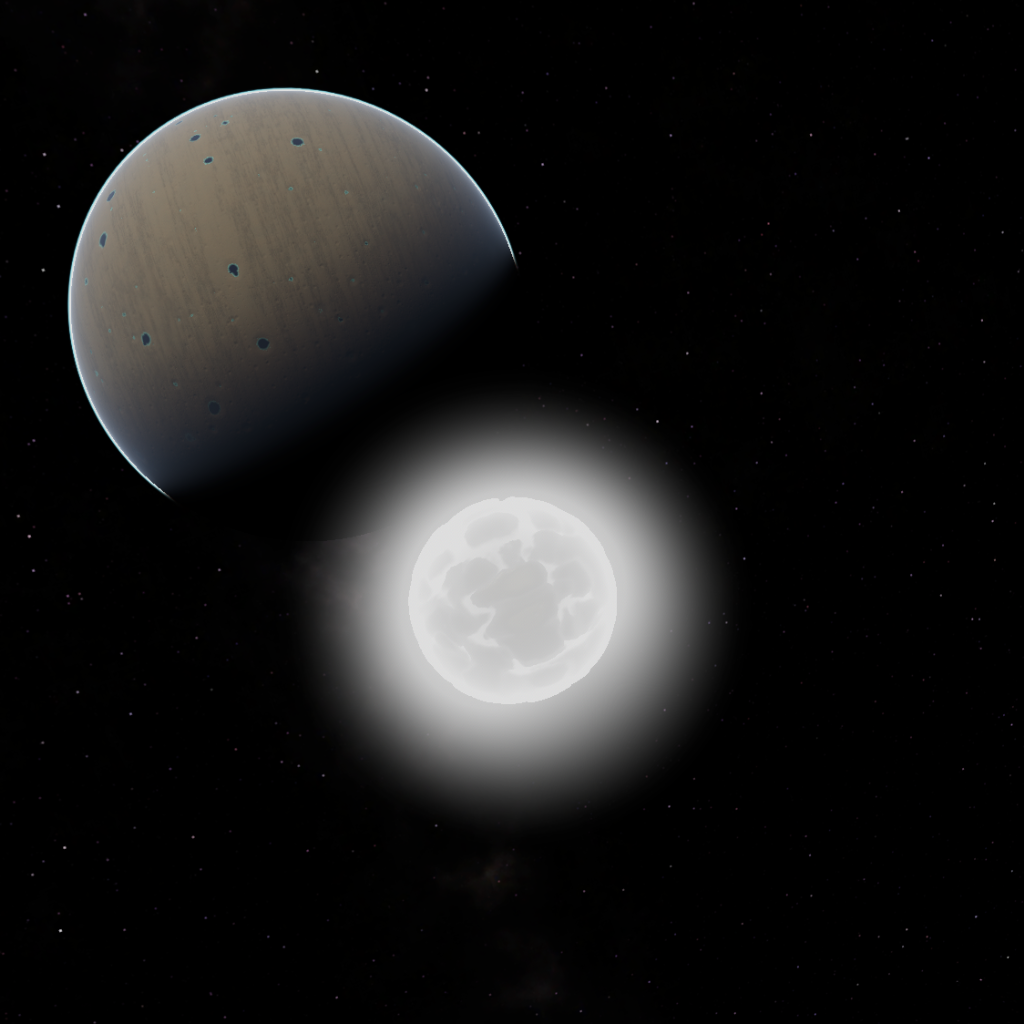
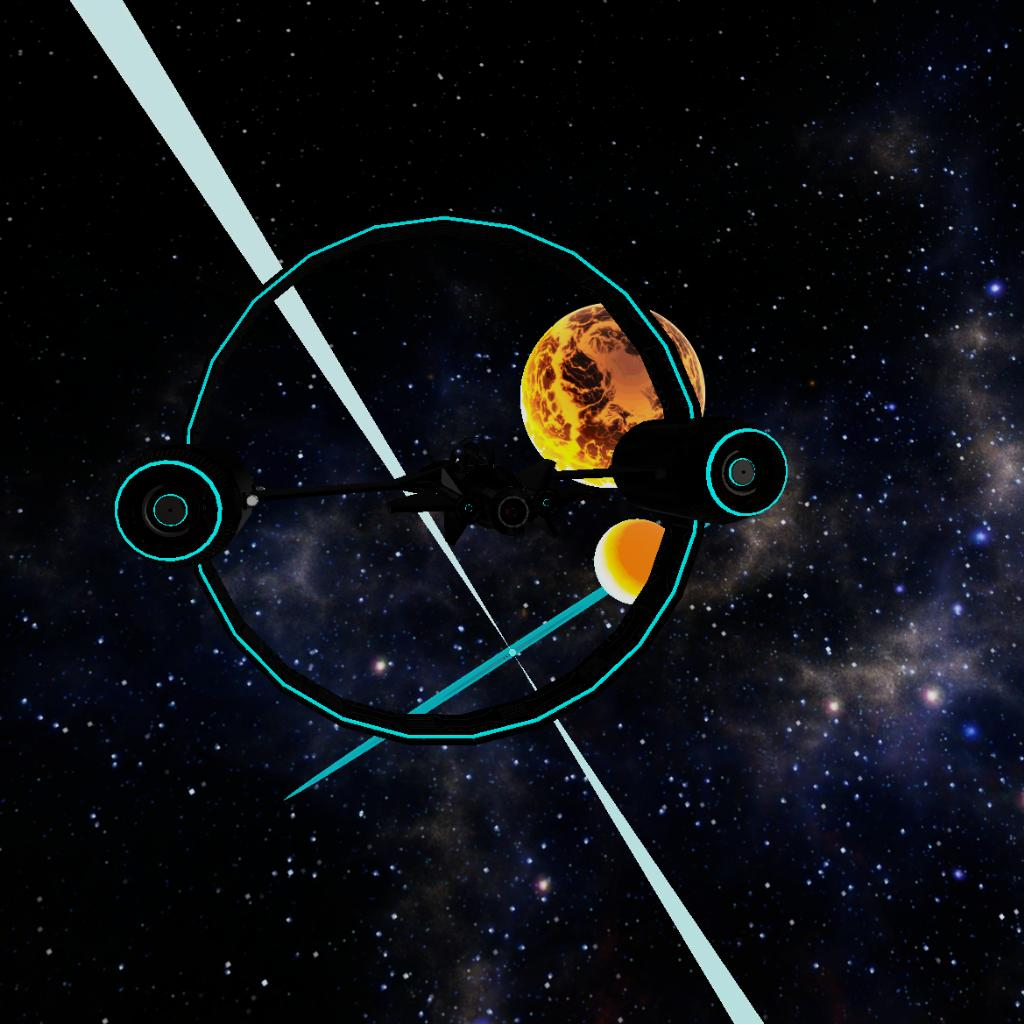
@Samps0n Sirius Bc is the flattest of all the planets. You could orbit 100m above the surface
Salt flats on a planet for crazy land races
Does this have the issue of only one light emitting source as far as solar panels ar concerned, cus i dont think the sun will provide even the weakest light in this, the only true stellar neighbourhood I have ran accross tho I am kinda new. And as far as the way I am taking this info in that the sun is the only thing not orbiting something, is this how the laws work in the program? You mentioned the barycentres and does that mean they need it to be programmed in leaving it free to calculate the other orbit? They each have individual gravity listed and I wondering if you had to come up with ithe barycentres yourself and if so are you an astrophysics expert? Does the program not always require the most massive body to orbit the smaller body or is that just the g/s2? As for an idea I have been wanting to practice deflecting, mining or using asteroids to build what I believe will incorporate the from end of our first true interstellar ships that are manned, asteroids. Maybe the ability to be able to have them small enough to move, close enough to get to from any rocky body that an early interstellar society would find practical, i dont require that all Droo exiting traffic lookout for the lighthouse on my ship hazard, now that would be cool, while not as effective as a Beacon in TRL but in-game that could have really cool effect. Would the lighthouse part even spawn in our games or is that a whole different can of worms?, one last thing you pointed out hundreds of days to get to %/c, considering you can't live for 3-9 months on under 8, or even 4 G's I would be confident that acceleration time begins 8-ish month maybe but most would likely accelerate/decelerate at 1-1.5 G's as tolerated, as a means of gravity
@SamTheFox I edited the post on PC
how did you get passed the 7 pic limit 0_0
I also made a system inspired by the Stellar neighbourhood u made. Its called the Gallo Ceti System.
How do u get the planets semi-major axis's over 1mil gm? pls tell
@GrandmasterPotato Describe the issue please so we can help.
How can anyone download this, it is glitchy on this page alone
New update. 3 new stars, Teegarden's Star, Van Maanen's Star, and 61 Cygni. Total body count now is 128, up from 94. Added Pluto-Charon. Linked are the new system maps. Update soon tm.
Drive: https://drive.google.com/file/d/191fbtXAFIoOeUum44TQYdskxZE9OXOHc/view?usp=sharing
Imgur: https://imgur.com/gallery/ShtU9uy
@wettoaster 《攻打三体人老窝》
不要回答!不要回答!不要回答!
Are like the ones of the ksp mod galaxies unbound
@sacr3dbac0n0 Pog
Teegarden's Star and one other mystery system in the works...a teaser for the next expansion... ;)
https://imgur.com/gallery/DZlRmih
@wettoaster It's a problem with the game, at high velocities and large distances, trajectories disappear. What you've got to do is burn fast enough that you get an intercept with your target's SOI, the minimum required should be around 100 km/s for the farthest star in the pack. Once you do that, wait until you hit its SOI, and then course adjustments should be easier. The faster the better. Same goes for brachistochrone type transfers to planets. Once you get close to a system, try toggling planet orbits off and on and if you are close enough they will return as normal.
Here's a guide, it's long, but hopefully it clears up anything.
https://www.simplerockets.com/Forums/View/139950/A-Guide-to-Interstellar-Navigation-Brachistochrones-Fuel-Budgeting-and-ISV-Des
uuuuuuuuuuh how come my ships flight path, and the path of the planets orbit disappear? like the moment my craft exists the sol system, its flight path vanishes and doesnt come back, makin it a little impossible to accurately fly to even alpha centauri
@sacr3dbac0n0 Ok, thanks for the information. Also, this is one of the best interstellar systems I have played, it really feels like a stock version of the Simple Universe. You and @lordvader0219 keep up the good work.
@Gen3ralInterstel1ar There's no XML editor to place planets at the distances as in this pack. You have to edit the XML file of the system on PC
@lordvader0219 @sacr3dbac0n0 Do either of you know of any good XML editors? I've been looking into doing a something similar.
@sacr3dbac0n0 Yea, I used a moderate powered ion engine and got to 2,500Mm/s in 2,500x timewarp within seconds. Very nice.
@W1ll1amTr1stan I see what you mean now. You are burning without timewarp, yes? I would highly advise using ion engines as they can burn through high timewarp. With that, an acceleration or decelleration burn can take me just 30 seconds. Most of far future technology that would enable STL intersteller travel would take a couple hundreds of days to accelerate up to cruise speed as well.
@sacr3dbac0n0 Also acceleration is quite slow, it took me ~3.7 minutes to reach 128,000Km/s. That's not too bad but if I want to decelerate, it will take approximately the same time to go to 23Km/s speed or so.
@sacr3dbac0n0 Also acceleration is quite slow, it took me ~3.7 minutes to reach 128,000Km/s. That's not too bad but if I want to decelerate, it will take approximately the same time to go to 23Km/s speed or so.
@sacr3dbac0n0 Yea, I don't know about that. Considering my ship has no payload, it is only used for extreme range travel. It's still quite slow though.